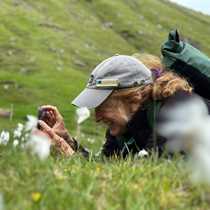J. Harlan Bretz encountered difficulties when he presented his theories to the scientific community on what is now referred to as the Bretz Floods. It took 40 years for Bretz to convince his fellow scientists that the presence of dry falls, giant ripple marks, loess islands, giant gravel bars, anastomosing channels, isolated mesas and buttes and erratics; huge rocks far from their origins all added up to a catastrophic flood event. Part of the evidence lay at our feet as we watched the Palouse River fall into a massive plunge pool; much too large a pool to have been carved by the present day falls.
The Lewis and Clark expedition made note of the Palouse River in their journals. However they named it Drewyer's River in honor of George Drouillard, a member of the Corps of Discovery. With the failure to publish the journals in a timely fashion, this name was not recognized by subsequent cartographers and hence the name Palouse was applied. Palouse comes from Indian words referring to the flat appearance of the terrain due to its absence of trees.




